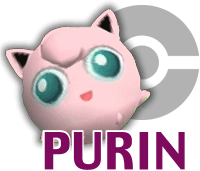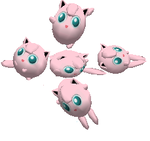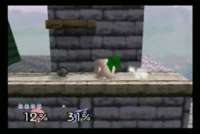Jigglypuff (SSB)
| Jigglypuff in Super Smash Bros. | |
|---|---|
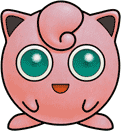 
| |
| Universe | Pokémon |
| Other playable appearances | in Melee in Brawl in SSB4 in Ultimate |
| Availability | Unlockable |
| Tier | B (6) (North America) ? (8) (Japan) |
Jigglypuff (プリン, Purin) is an unlockable character in Super Smash Bros. Mainly included due to its similar appearance and nature to Kirby, they share many moves in common, making them semi-clones. It is the floatiest and lightest character in the game, a trait it has kept in subsequent appearances.
Jigglypuff is voiced by Mika Kanai in Japanese, Rachael Lillis in English, Guilaine Gibert in French, and Mara Winzer in German. Some of Mika Kanai's recordings are from episodes 45 and 62 of the Pokémon anime. Rachael Lillis recalled not having any visual reference when recording her own lines.[1]
Jigglypuff ranks 6th in the B tier. It is notable for being the lightest, floatiest, and lowest gravity character in the game. Jigglypuff has many low knockback attacks, which when combined with its floatiness, can be used to its advantage by gimping opponents or carrying them all the way to the lateral blast lines. It also has some moves with disproportionate power, like its up smash, back throw, and the infamous Rest.
However, because Jigglypuff is so light and floaty, it is very easy to KO. In addition, Jigglypuff lacks a rising up special for recovery, forcing it to rely on its remaining midair jumps and Pound to recover, while making it easy to gimp if its jumps run out.
Like its placement would suggest, Jigglypuff has slightly favorable matchups in the current metagame, and has achieved above average tournament representation and results in the hands of players like wangera. However, Jigglypuff ranks worse in Japan at 8th, due to other characters being more powerful by comparison.
How to unlock[edit]
Complete 1P Game, then defeat Jigglypuff on Saffron City. Players that lose the fight against Jigglypuff can re-fight it by completing 1P Game again. If the 1P Game criteria for Ness and/or Captain Falcon is met simultaneously and they have not been unlocked, then the player will fight one of them instead of Jigglypuff.
Attributes[edit]
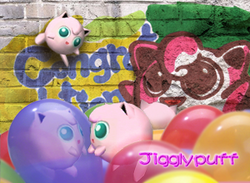
Most of Jigglypuff's moveset consists of low knockback attacks. Its great aerial mobility makes up for the fact that it has the second slowest dash speed. It can also use the teleport technique to help with its ground game. Jigglypuff also has in its arsenal surprisingly powerful finishing attacks, such as its up smash.
Jigglypuff's ground attacks are generally slow and weak, other than its smashes. Neutral attack, forward tilt, and down tilt have little use in general. Up tilt is also weak but can be used for combos at low-mid percentages, and it can lead into an up smash or Rest as a finisher. Forward smash is a decent finisher at high percents, up smash is one of the strongest in the game, while down smash sends the opponent at a semi-spike trajectory, making it useful for edgeguarding. Jigglypuff has some good aerials, with a good edgeguarding ability. Its down air can meteor smash, but it’s weak, which makes it better at setting follow ups.
Jigglypuff has a unique set of special moves, which can be considered "extreme". They all tend to have incredible strengths bundled with terrible weaknesses. Its neutral special move (Pound) has short range (like all of Jigglypuff's moves) and a decent amount of startup lag, but it also does high damage, solid knockback, a lot of shield damage, and can easily give Jigglypuff additional recovery, especially horizontally. Its down special move (Rest) is known for having incredible strength if it connects, considerable ending lag, zero startup, poor range, and providing invincibility frames until its eyes close. It is an excellent combo finisher, and can be comboed into from a variety of follow ups such as up tilt, down air and up air. Its forward throw can be comboed into Rest for a kill at mid percents against fast fallers like Captain Falcon, Fox, Link along with characters with high falling speed such as Yoshi and Donkey Kong, which is known as the Space animal slayer. Its up special move, Sing, puts opponents to sleep, but unlike in future games, it keeps opponents asleep longer at low percentages. This allows it to start combos at low percents.
On the receiving end, Jigglypuff's floatiness, low weight, and small size make it difficult to land long combos on it. Furthermore, Jigglypuff's slow falling speed, five midair jumps, good air speed, and Rising Pounds allow it to recover from almost any distance horizontally. On the downside, its vertical recovery is very bad due to only three of its midair jumps giving actual height (its fourth midair jump gives next to no height, and its fifth merely slows its descent) and it lacking a rising up special move. This makes it very vulnerable to meteor smashes and semi-spike attacks like Fox's Shine spike. Also, Jigglypuff's slow falling speed makes it very easy to juggle, and very vulnerable to characters with powerful vertical finishers, such as Fox with his up smash and up aerial. Light weight also has its downside, as Jigglypuff will often be knocked out at earlier then any other character. If Jigglypuff's shield breaks when there is no ceiling, it will be Star KOed, so Jigglypuff players must be very careful when shielding multi-hit attacks and attacks that cause high shield damage. This is problematic in certain matchups, like Yoshi, who posses strong shield break combos.
Differences between game versions[edit]
NTSC-J to NTSC-U[edit]
Jigglypuff was buffed overall in the transition to NTSC-U, with the longer range on its down smash helping it edgeguard opponents, and the much higher power of Rest making it a go-to finisher out of a combo. However, the removal of momentum sliding slightly hurts its approach, and the strengthening of DI makes its combos easier to escape, especially those involving dair. Overall, Jigglypuff is slightly better than in the Japanese version.
Aesthetics[edit]
 Jigglypuff has all new voice clips due to its name change from "Purin" to "Jigglypuff".
Jigglypuff has all new voice clips due to its name change from "Purin" to "Jigglypuff". Jigglypuff has a different blinking pattern while taunting.
Jigglypuff has a different blinking pattern while taunting.
Attributes[edit]
 Taunt has less ending lag (FAF 67 → 61).
Taunt has less ending lag (FAF 67 → 61). The removal of momentum sliding slightly hinders Jigglypuff's approach.
The removal of momentum sliding slightly hinders Jigglypuff's approach.
Ground attacks[edit]
 Down smash has more range on both sides as its foot hitboxes have been repositioned to cover the space past Jigglypuff's feet rather than its legs (x offset: 100 → 200).
Down smash has more range on both sides as its foot hitboxes have been repositioned to cover the space past Jigglypuff's feet rather than its legs (x offset: 100 → 200).
Special attacks[edit]
 Rest deals more damage (14% → 20%) and knockback (20 (base), 140 (scaling) → 60/120), significantly improving its KO potential.
Rest deals more damage (14% → 20%) and knockback (20 (base), 140 (scaling) → 60/120), significantly improving its KO potential. Rest now makes the ping sound effect when it connects rather than a heavy kick sound.
Rest now makes the ping sound effect when it connects rather than a heavy kick sound.
NTSC-U to PAL[edit]
Jigglypuff was nerfed in its transition to PAL. While it indirectly benefits from the Teleport glitch covering more distance, which in turn gives Jigglypuff better approach options, down aerial and especially Rest have smaller hitboxes; making them harder to land.
Aesthetics[edit]
 Jigglypuff has all new voice clips when the game is set to French or German due to its name change from "Jigglypuff" to "Rondoudou" and "Pummeluff" respectively. This is specific to the European version of the game, as the Australian version and iQue version only contains English.
Jigglypuff has all new voice clips when the game is set to French or German due to its name change from "Jigglypuff" to "Rondoudou" and "Pummeluff" respectively. This is specific to the European version of the game, as the Australian version and iQue version only contains English.
Attributes[edit]
 Teleport goes farther, making it a better approach option.
Teleport goes farther, making it a better approach option.
Aerial attacks[edit]
 Down aerial has smaller hitboxes (180u/180u → 170u/170u).
Down aerial has smaller hitboxes (180u/180u → 170u/170u). Down aerial auto-cancels later (frame 33 → 40).
Down aerial auto-cancels later (frame 33 → 40).
Specials[edit]
 Rest has a catastrophically smaller hitbox (130u → 60u).
Rest has a catastrophically smaller hitbox (130u → 60u).
Moveset[edit]
For a gallery of Jigglypuff's hitboxes, see here.
| Name | Damage | Description | ||
|---|---|---|---|---|
| Neutral attack | Left Tap (左たたき, Left Thrash) Right Tap (右たたき, Right Thrash) |
3% | Jigglypuff performs two stubby punches. The first hit is usually used in the middle of combos for some extra damage. The second hit has a bit more ending lag, but it deals more damage and it launches opponents upwards, giving it setup potential. It is overall similar to Kirby's, but with more startup lag, and Jigglypuff has no rapid jab. | |
| 4% | ||||
| Forward tilt | Rolling Kick (まわしげり, Roundhouse Kick) | 8% | Circles in place and kicks. Can be angled. Very weak for a forward tilt, but it does not have too much ending lag. | |
| Up tilt | Back Kick (うしろあしげり, Back Leg Kick) | 10% | Swings a foot behind, hitting above its head for a low knockback attack that sends the opponent up at a steep angle. If hit at the correct spot, this attack can be used repeatedly as an u-tilt chain or as a setup for more powerful attacks. However, at low percents, the sourspot (closest to Jigglypuff) is very punishable and has knockback similar to a jab. It is, essentially, a slower, weaker version of Kirby's version, with a longer animation and less disjointed range. | |
| Down tilt | Leg Sweep (あしばらい) | 10% | Jigglypuff kicks forwards while crouching. The move sends the opponent upwards at a 70 degree angle. The move has high startup and ending lag, giving it limited utility. | |
| Dash attack | Sliding (スライディング) | 10% (clean), 6% (late) | A generic dash attack, Jigglypuff trips over and slides, hitting opponents in front of it. | |
| Forward smash | Lunge Kick (とびこみげり, Plunge-In Kick) | 16% (clean), 10% (late) | This attack sends Jigglypuff forward with a quick burst of speed. It is similar to Kirby's forward smash, except it has more startup lag, and it deals less damage and knockback. Despite this, Jigglypuff's forward smash still has low startup lag for a forward smash and it still has above average knockback, making it a solid forward smash overall. | |
| Up smash | Headbutt (ずつき) | 18% (clean), 10% (late) | Rocks its head back then forward for an attack. The move comes out fairly quickly, and it sends the opponent upwards, dealing high damage and very high knockback. It is one of the strongest up smashes in the game. At the last few frames of the attack, the move launches opponents horizontally, and deals much less damage and knockback. It is overall a solid up smash. | |
| Down smash | Jiggly Split (りょうあしげり, Both-Feet Kick) | 16% (clean), 10% (late) | Does a split, sending opponents on either side at a somewhat low angle. The hitbox extends quite a bit beyond Jigglypuff's feet, and this disjointed hitbox is most often used for edgeguarding, as it allows the player to avoid getting hit by the recovering opponent, while still being able to prevent the opponent from grabbing the ledge. It can also attack opponents already on the ledge. Has noticeably less range in the Japanese version. | |
| Neutral aerial | Jigglypuff Kick (プリンキック) | 14% (clean), 9% (late) | Extends a foot out, sending the opponent back. It is similar to Kirby's, although it is slower and weaker. It is the slowest neutral aerial in the game in terms of startup lag although it still comes out fairly quickly. It has above average knockback, has a noticeably disjointed hitbox, and lasts for quite a while, making it a great spacing and edgeuarding option. | |
| Forward aerial | Front Kick (まえげり) | 13% (clean), 9% (late) | Leans back and extends both feet out. The attack is not particularly strong, but it can be used for combos. | |
| Back aerial | Spinning Back Kick (うしろげり, Back Kick) | 13% (clean), 9% (late) | Spins and kicks backwards. Back aerial is fairly weak, and it can be chained into itself multiple times. The move does have short range however. | |
| Up aerial | Clean Sweep (なぎはらい, Mow-Down) | 16% | Slaps upwards, making an arc with its arm, sending opponents upward with high knockback. The hitbox extends throughout its body. Because the knockback is consistent throughout the hitbox, if the opponent is hit at the lower part of the hitbox, it may set up for aerial combos. Can KO floaty opponents at moderately high percents. | |
| Down aerial | Spinning Kick (かいてんげり, Rotating Kick) | 3% (hits 1-10), 30% (total), 3% (landing) | Like all drill kicks (other than Kirby's), this attack has very low knockback and traps the opponent. When Jigglypuff lands while hitting the opponent with this attack, it can be followed up with almost any ground attack, depending on the DI. It is a very weak meteor smash, but can nonetheless be used for edgeguarding. 3% per hit (total 10 hits). The move also has a landing hit, which can actually be quite useful, as the move has very low landing lag. | |
| Grab | Grab (つかみ) | — | ||
| Forward throw | Tornado Throw (たつまきなげ) | 14% | Jigglypuff throws the opponents straight up. This is both bad and good, as the attack rarely KOs and can't set up edgeguards, but at low percentages, it can be useful for combos. | |
| Back throw | Brain Buster (ブレーンバスター) | 16% | Jigglypuff slams the opponent backwards. It is overall a fairly standard back throw, having a good amount of power. | |
| Forward roll Back roll |
— | — | ||
| Techs | — | — | ||
| Floor attack (front) Floor getups (front) |
6% | Spins around on both sides, kicks, then gets up. | ||
| Floor attack (back) Floor getups (back) |
6% | Spins around on both sides, kicks, then gets up. | ||
| Edge attack (fast) Edge getups (fast) |
4% | Does a flip while curling and sticks it's foot out. | ||
| Edge attack (slow) Edge getups (slow) |
4% | Slowly gets up and lunges forward with its body. Will not hit foes right next to the ledge where Jigglypuff is. | ||
| Neutral special | Pound | 13% | Does a punch forward which gives a bit of distance forward in midair. Usually used as a recovery move, as it can be aimed upwards and down, the former is referred to as Rising Pound and, when combined with midair jumps, can give Jigglypuff a good horizontal recovery, although an accidental input will cause Jigglypuff to use Sing, not useful for recovery. (This technique is required to complete Jigglypuff's Board the Platforms level.) The hitbox stays out surprisingly long and the attack does high shield damage. During the end lag, Jigglypuff can fast fall. | |
| Up special | Sing | — | Jigglypuff sings while staying in place and creating music waves. Any nearby grounded opponents will be sent to sleep if they get caught by the waves. Unlike in later games, opponents sleep for longer at lower percentages. Unlike most up specials, it is not a recovery move, and will most certainly lead to a self-destruct if used offstage due to its long ending lag. The move heavily suffers from having its short range (hampered by the fact that it does not work on aerial or shielding opponents), long startup lag and extremely long ending lag, with the entire move taking 3 seconds to complete. Even at lower percents, the opponent can mash out of the sleep and punish Jigglypuff before Jigglypuff has even finished singing. Jigglypuff can use Sing after a teleport to use the move while approaching but overall, it is considered one of the worst moves in the game, with its extreme flaws making it borderline useless. | |
| Down special | Rest | 20%, 14% (NTSC-J) | Falls asleep for approximately 4 seconds, unable to perform any action during its duration. Jigglypuff has brief intangibility during the startup until its eyes close. However, with the extreme ending lag, it is not a good option to dodge attacks with, as the opponent can use almost any attack afterwards. Similar to Sing, using this move offstage will lead to a self-destruct. Normally, it leaves Jigglypuff very vulnerable, but if the opponent is right next to it, they will be sent flying by the attack. It is a powerful move (more powerful than the Falcon Punch if used near the horizontal blastzone) that deals a lot of damage, has high knockback, and can be combo'd into using an up tilt or any aerial, with these combos being possible at a variety of percentages using various moves. Much weaker in the Japanese version and it has a smaller hitbox in the PAL versions. | |
Announcer call[edit]
English/Chinese
Japanese
French
German
On-screen appearance[edit]
- Releases from a Poké Ball, similar to Pikachu.
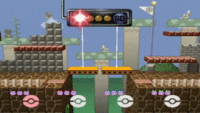
|
|---|
Taunt[edit]
- Inflates, puts its arms in front of it, then rocks to its right, then to its left, then to its right again, accompanied by it blinking and saying "Jigglypuff!" (プリプリーン!). Interestingly in the Japanese version, the taunt has a slightly different animation, with Jigglypuff blinking at different times. The taunt also cannot be cancelled as early in the Japanese version.
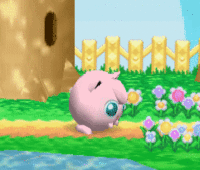
|
|---|
Crowd cheer[edit]
| Cheer (English/Chinese) | Cheer (Japanese) | Cheer (French) | Cheer (German) | |
|---|---|---|---|---|
| Cheer | ||||
| Description | Jigglypuff! | Purin! | Ron - dou! Rondoudou! | Pum - me - luff! |
Victory poses[edit]
- Jiggles around, then faces the camera directly (also its character select animation).
- Swings its body from side to side and nods.
- Rests and suddenly wakes up.
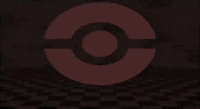 |
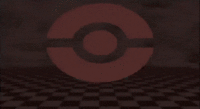 |
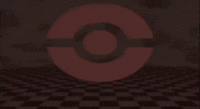
|
|---|
In competitive play[edit]
Most historically significant players[edit]
- See also: Category:Jigglypuff players (SSB)
CTG - The second best Jigglypuff player in the world. He has shown major Jigglypuff results only behind wangera with 5th at Shine 2017 and 9th at GENESIS 5. He is the only person to be ranked in the top 20 on the 64 League Rankings for two years in a row as a solo Jigglypuff main, doing so in 2017 and 2018 and has been on the rankings since its inception.
Isai - One of the best Smash 64 players of all time who is efficient with the entire cast. He won Apex 2014 only using Jigglypuff and beating top players such as Moyashi and Mariguas, which marks the only North American major the character has ever taken.
Ron - A player during the old-school era with very rare showings. Despite this, he won the first ever Kansai event with 1st Kansai, taking it over players such as Moyashi and placed 3rd during 2nd Kansai.
takuro~ - The second best Jigglypuff player in Japan. He held some of the best Jigglypuff results in the country before wangera competed with a 2nd at Kanto 2011 where he picked up a notable win over Prince and 5th place at Kanto 2014. He continued to compete with high results in Kanto events before retiring in 2018.
wangera - The best Jigglypuff player of all time. Won Kanto 2016, being the first solo Jigglypuff player to win a Japanese tournament since Ron's run at 1st Kansai. He has shown some of the best Jigglypuff results seen in North America as well, with his 3rd at GENESIS 3 and 5th at Super Smash Con 2016.
Waxy:Joe - The second best Jigglypuff player in the United States in the recent meta. Some of his best performances are 9th at Xanadu Origins and 25th at Super Smash Con 2023, the latter being where he defeated Alvin and tacos. He is currently ranked 31st on the 2023 Smash 64 Power Rankings.
YBOMBB - One of the best players from Canada using Jigglypuff as a co-main. He has placed 4th at The Big House 9 and 9th at Apex 2013, as well as beating Preston and Nintendude with the character. He was at one point considered the best player in Ontario during the September 2014 rankings.
Yunque - One of the best Jigglypuff players in the United States before going inactive after 2018. His best performances were back-to-back 9ths at Shine 2016 and Shine 2017. He became the second solo Jigglypuff player to be ranked on the 64 League Rankings consecutively for two years, doing so with 47th and 48th placement on the 2017 and 2018 rankings, respectively.
Tier placement and history[edit]
Jigglypuff's tier placement has stayed relatively consistent throughout the metagame as a mid-tier character. It was placed at 6th place on the first SSB64 tier list. With a solid recovery and edgeguarding ability, it could hold its own against high tiers with exploitable recoveries like Ness. As time went on, however, its low survivability became more apparent, not helped by the rise of characters that it struggled with such as Fox and Yoshi, the former whose up smash allowed for early kills, and the latter with amazing shield pressure. All this led to it dropping to 9th place in the second tier list, at the bottom of B tier. Jigglypuff would eventually rise again to 8th in the third tier list, and then again to 6th in the fourth tier list, largely because of favorable tournament results it achieved at the time. Jigglypuff is currently 8th on the Japanese tier list; this lower position is due to Rest being a far weaker kill option compared to international versions.
Techniques[edit]
Teleport[edit]
A technique that allows Jigglypuff to gain a quick forward burst of movement during a run. Jigglypuff can attack, jump, or perform other actions out of the slide (it even allows it to go offstage), and the speed boost can be used to surprise opponents at a distance, due to the large boost over Jigglypuff's normal running speed.
Rising Pound[edit]
Using Pound and tilting the control stick up immediately after will cause Jigglypuff to rise up during the move's animation, which can largely increase its horizontal recovery, and is its only real shot at vertical recovery outside its midair jumps.
Fake ledge jump[edit]
(see here).
Profile[edit]
The Balloon PKMN with the big, round eyes. It sings a soothing melody, sending those that hear it to sleep. When mad, it puffs itself up. As a Balloon PKMN, its body is light, weak, and easy to knock away.
| Works (International) | Works (Japanese) |
|---|---|
| Pokémon (GB) | ポケットモンスター (96.2/GB) |
Alternate costumes[edit]

| |||
Trivia[edit]
- On the character selection screen, Jigglypuff's portrait greatly resembles its artwork from Pokémon Red/Green.
- According to an interview with Masahiro Sakurai in the May 1999 issue of The 64 DREAM, both Jigglypuff and Clefairy were considered to be added to the game as a clone of Kirby, with Jigglypuff ultimately being chosen for the game.[2]
References[edit]
- ^ Rachael Lillis Voice Actor Panel at Game On Expo 2019
- ^ The 64 DREAM May 1999, p. 91. ところで、「どうして隠しキャラにプリンが?」っていう意見もあったりするんですが。 / ふつうの格闘ゲームは、基本になる骨格などを一緒に作って、やられるモーションなども使いまわすことができるんです。でも「スマブラ」の場合は基本の8キャラがすべて異なる体型で作られているんですね。その上、やられパターンとか倒れパターン、それに起き上がりら攻撃パターンや崖捕まりパターンなど、それぞれ違う作りをしていて、それらを全て作るのは、ふつうの格闘っていうレベルでみてもすごく大変なことなんです。それで、隠れキャラは基本キャラの骨格を使い回すことを前提にしたんです。なので、ネスとルイージはマリオと同じ骨格でできてるし、ファルコンはサムス、プリンはカービィと一緒というわけなんです。プリンを選んだのはそういった骨格の類似性もありましたが、それとは別に、「人気ポケモンは?」って考えたときに、最後まで残ったのがピッピとプリンだったんですね。カービィ体形でピッピを作ることも可能だったと思いますけど、とりあえずキャラクター的な性格からして、プリンの方がやられ役っぽさがあったので選びました。
| Fighters in Super Smash Bros. | |
|---|---|
| Fighters | Captain Falcon · Donkey Kong · Fox · Jigglypuff · Kirby · Link · Luigi · Mario · Ness · Pikachu · Samus · Yoshi |
